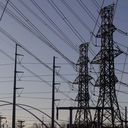How Texas' power grid weathered the latest freeze

Texas' power grid comfortably endured another winter test this week after the state was blasted with Arctic cold air that sent temperatures plummeting.
Why it matters: Texas' grid has been vulnerable to winter and summer weather extremes and has faced intense scrutiny since mass power outages during a historic multi-day winter storm in February 2021 contributed to hundreds of deaths.
- Since then, the state has required improvements to aspects of the grid, like natural gas power plants, to make them less susceptible to frigid temperatures.
- The Electric Reliability Council of Texas (ERCOT), the manager of the grid, has also greatly expanded battery storage capacity throughout the state to help meet high demand during extreme temperatures.
Context: Months before the recent Arctic outbreak bore down on the U.S., ERCOT warned that there was a one-in-six chance the grid could suffer outages if the state saw a winter storm similar to the one it experienced in December 2022.
- During that storm, cities across the state saw between two and three days of temperatures at or below freezing, but the grid met record energy demand while limiting weather-related outages.
With temperatures expected to nosedive from the cold air heading south, ERCOT issued a "weather watch" on Sunday, anticipating high demand as customers turn to heating and a possibility of reduced energy reserves, particularly during morning hours.
- As frigid temperatures settled in, the grid operator asked its 26 million customers to conserve power on Monday and Tuesday morning, which is particularly hard for the grid during the winter.
- In a typical winter day in the state, one of two peak energy demand periods occurs during winter morning hours.
- But the morning peak is met with reduced solar and wind energy production — as the sun isn't shining and winds are calmer — and an increased chance of malfunctions with power plants and natural gas supply.
By the numbers: Energy demand soared as minimum temperatures in Dallas, Austin, San Antonio, Houston and other cities began to fall in the mid-20s and teens beginning on Sunday.
- Texas then saw three consecutive unofficial winter demand records throughout the freeze, with the peak topping out at 78,138 megawatts on Tuesday morning. (ERCOT couldn't measure peak demand during the 2021 storm, and it was likely higher than the new record.)
- Tuesday's peak demand will likely be the state's third highest, being around 7,370 megawatts (MW) lower than the all-time record set in August 2023.
Details: Later that afternoon, a new solar power generation record was set, with panels around the state contributing 14,835 MW to the grid, or around 20% of the total generated power at the time.
- Wind also accounted for 30% of the power generated during the now-broken winter demand record set Monday night.
What they're saying: Woody Rickerson, an ERCOT senior vice president and its COO, said during a public utilities meeting on Thursday that this week's freeze was the state's second-longest winter storm in the past 15 years and its third coldest.
- Rickerson said surplus energy from solar generation throughout the storm helped charge batteries and gave operators a chance to correct issues at thermal plants.
- "This is the first time we've seen operational days significantly affected by the amount of solar during a winter storm," he said.
- Rickerson noted that solar generation varied greatly day by day based on cloud coverage.
Yes, but: Conditions this week, though severe, were significantly better compared to those during the historic 2021 winter storm, which brought about several consecutive days of extremely abnormal freezing temperatures combined with several inches of rain and snowfall.
- That means the most recent test may not be an accurate depiction of how the grid may perform in worse weather, according to Joshua Rhodes, a researcher at the University of Texas at Austin.
- "But the fact we got through this without really any major issues I think should give some confidence that the system can survive the 'normal' extreme weather events," Rhodes said.
Doug Lewin, the author of the Texas Energy and Power Newsletter, said the grid performed much better than it did during the 2022 freeze, with power loss from plant outages being roughly cut by half this time around.
- But there's still room for improvement, according to Lewin and Rhodes, specifically with energy efficiency, ERCOT's ability to project energy demand and resolving reliability issues with the natural gas supply.
Meanwhile, Texas' grid wasn't alone in struggling with extreme winter weather.
- For example, Omaha residents were asked to conserve energy during the Arctic temperatures this week.
The big picture: Recent studies suggest polar vortex incursions may increase in frequency in a world warming from excess greenhouse gases in the atmosphere.
- Though Texas' winters are expected to become milder because of human-caused global warming, the state could see more frequent freezes from incursions of polar air.
- Hotter summers are also expected to continue to strain Texas' grid unless additional improvements are made, though generally, all power grids around the country face this risk.
Bottom line: Rhodes noted the end of winter is still several weeks away, pointing out that February is typically Texas' coldest month.
- "There's probably more cold weather to come, and it could be worse," Rhodes said.
Go deeper: IEA: Power grids falling far short in fight against climate change